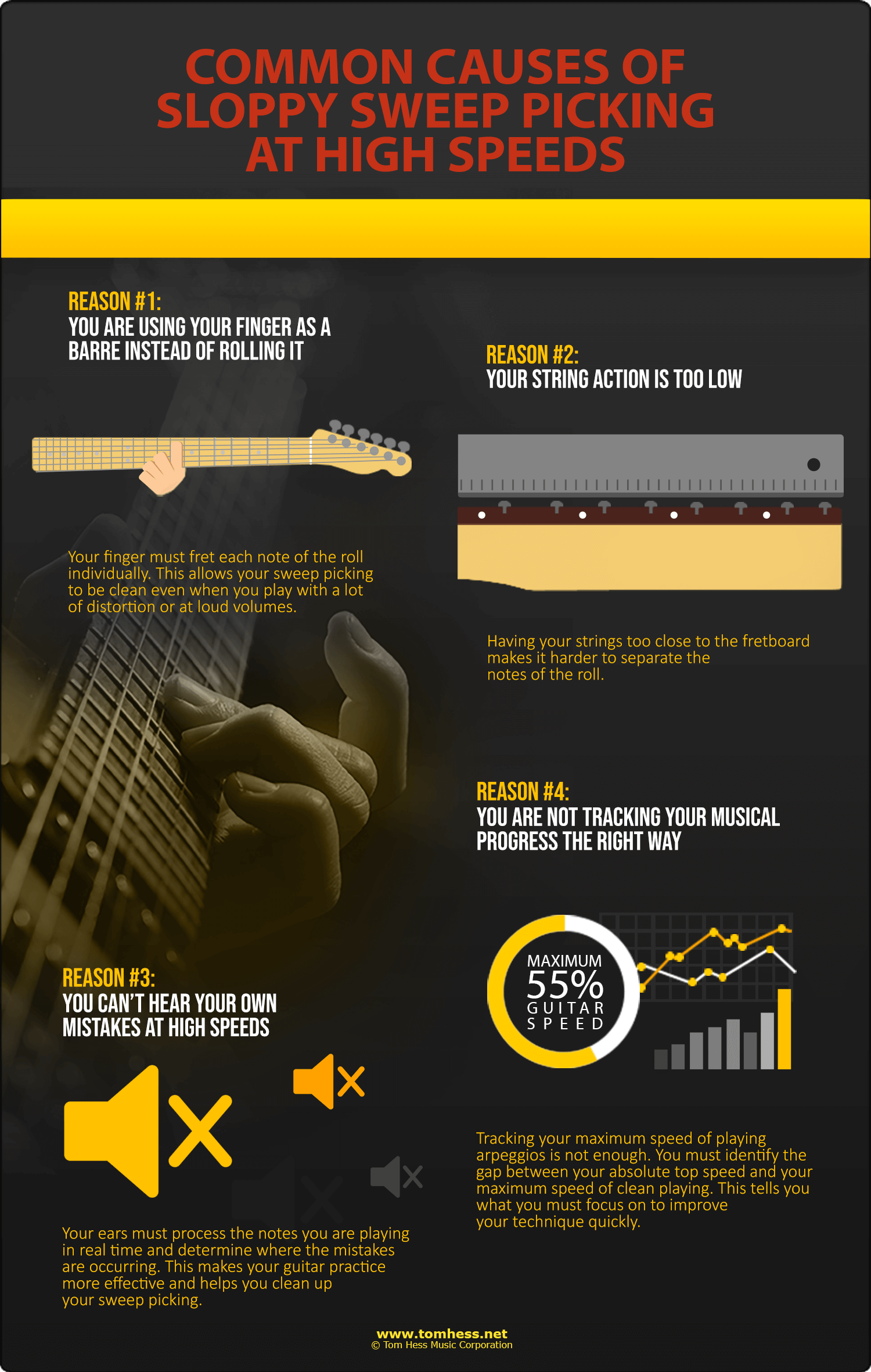These Lead Guitar Arpeggios Sound Pro And Make It Easy To Create Awesome Guitar Licks

EMAIL TO GET ACCESS
By submitting your info, you agree to send it to Tom Hess Music Corporation who will process and use it according to their privacy policy.
Want to play awesome guitar arpeggio licks and create pro-sounding guitar arpeggio sequences that impress nearly everyone who hears your guitar licks?
Well, then...
You're in the right place.
Because this lead guitar article will help you do just that.
To begin...
I’ll show you simple guitar arpeggio licks you can plug into your very next guitar solo.
(They sound great even if you can’t play any fast guitar licks yet.)
And then...
I’ll show you how to turn those arpeggio guitar licks into entire ‘sections’ of a solo that sound cool and musical.

EMAIL TO GET ACCESS
By submitting your info, you agree to send it to Tom Hess Music Corporation who will process and use it according to their privacy policy.
Plus, along the way...
I give you guitar practice tips that help you master these (and other) guitar arpeggio licks quickly and sound pro when you play them.
Ready to have fun?
First, watch the video below to learn cool lead guitar arpeggio licks:
Now, let’s go deeper into the art of playing guitar arpeggios.
Here are 5 more guitar practice tips for spicing up your arpeggio guitar licks:
Guitar Practice Tip #1 For Playing Cool Guitar Arpeggio Licks: Learn All The Possible Inversions Of Each Arpeggio
When you learn a 3-note guitar arpeggio (e.g. a major, minor, diminished or augmented guitar arpeggio), you can play it in ‘root position’ (starting with the root of the chord)...
The 1st inversion (starting with the 3rd of the chord)...
Or the 2nd inversion (starting with the 5th of the chord).
Each of these inversions can be played using its own lead guitar arpeggio shape.
And when you learn them, you can connect them together to create lead guitar arpeggio sequences that sound awesome (even when played slowly).
The good news is: you only need to learn these lead guitar arpeggio shapes one time.
Because once you learn the 3 shapes for the major guitar arpeggio for example – you know how to play inversions of the major arpeggio in ALL 12 keys. This makes it very easy to play (and create) guitar licks using arpeggio sequences.
This is one of the advantages us guitar players have over piano players (for example). Piano players have to learn a new set of arpeggio shapes for each key.
Note: some of the guitar arpeggio shapes contain finger rolling. What is finger rolling?
It’s a way to play notes on the same fret across different strings – with the same finger.
It’s a technique many lead guitar players struggle with (because if you do it wrong, it’s incredibly easy to let your notes ring together – making your arpeggio sequences (and your guitar licks) sound sloppy).

But fear not...
Here are some guitar practice tips that help clean up your finger rolling and make it easy to master this element of guitar arpeggio playing:
Common mistake to avoid: Don’t think (or speak) of finger rolling motions as ‘barring’. There is NO barring involved in playing arpeggio sequences.
If you think of finger rolling as barring – you are bound to let the notes of your guitar arpeggios ring together, making your lead guitar licks sound very sloppy. This guitar technique video explains this idea in more detail.
Guitar Practice Tip #2 For Playing Cool Guitar Arpeggio Licks: Play Arpeggios In One Direction
Playing guitar arpeggio licks in only one direction (e.g. only ascending or only descending) sounds great because it breaks the listener’s expectation to hear arpeggios played both up and down.
This adds a ton of musical interest to your lead guitar licks and makes you sound pro (no matter if you are playing guitar arpeggios fast or slow).
Here are some ideas that will help you create guitar licks using this guitar practice approach:
- Mix up regular up and down guitar arpeggios with guitar arpeggios played only ascending.
- Mix up regular up and down guitar arpeggios with guitar arpeggios played only descending.
- Create arpeggio sequences by playing guitar arpeggios in only one direction through all inversions of a chord.
Here are some demonstrations of these ideas in action:
Question: “Tom Hess, when I'm descending a guitar arpeggio, do I play its lowest note with an upstroke or a downstroke before I return back to the high E string?”
Answer: Play it with an upstroke – exactly as you would if you were to continue descending the guitar arpeggio. That said, make sure your guitar pick comes away from the strings on the upstroke that turns your guitar pick around.
This allows for a smooth return of the pick back to the high E string and enables you to play your lead guitar arpeggios cleanly (even if you aren’t able to play them fast yet).
Bonus tip: as cool as it is to play guitar licks (and arpeggios) in one direction, do not overuse this way of playing guitar arpeggios.
Any lead guitar technique loses its coolness and emotional power if overused. Simply add this style of playing arpeggio sequences into your lead guitar toolbox and mix it up with other ways of playing arpeggio guitar licks during your guitar practice.
Guitar Practice Tip #3 For Playing Cool Guitar Arpeggio Licks: Combine Arpeggios With Tremolo
This is one of my favorite ways to spice up arpeggio sequences and create cool arpeggio guitar licks.
All you do is sweep pick through the arpeggio and stop on any of its notes using tremolo picking.
Here is why this creates a great sound in your arpeggio sequences:
1. It is a great test of how well you can keep your hands in sync when you play guitar arpeggios. Stopping on a tremolo picked note in the middle of a sweep picking arpeggio sequence is harder than it sounds. But when you can do it well – it’s a great sign that you are on your way to mastering the technical aspect of sweep picking.
2. Combining guitar arpeggios with tremolo creates very aggressive-sounding lead guitar licks that add a great deal of fire and intensity to your arpeggio sequences.
Here is a video demonstration of this lead guitar technique in action:
Question: “Tom Hess, when I'm combining guitar arpeggios with tremolo, what metronome tempo do I practice at?”
Answer: Practice this lead guitar idea in free time (meaning – without the metronome). Yes, believe it or not, you don’t need to use the metronome all the time when you practice lead guitar. There are some lead guitar techniques that are best practiced in free time (this idea of combining arpeggio sequences with tremolo is one of them).
Question: “Tom Hess, how many times do I tremolo pick a string when combining tremolo picking with guitar arpeggios?”
Answer: Go entirely by feel here (which is one reason why you should practice this lead guitar idea without the metronome). That said, you will typically be doing short bursts of tremolo when using tremolo picking with arpeggio sequences. So, anywhere from 3-8 pick strokes should be enough in most cases.
The exact number may vary from one lead guitar lick to another, so again – go by feel.
Guitar Practice Tip #4 For Playing Cool Guitar Arpeggio Licks: Use Speed Bursts To Build Guitar Speed In Your Arpeggio Sequences
Yes, even though lead guitar arpeggio sequences I’ve shown you so far sound great at any speed (fast or slow)...
You can also build plenty of speed with guitar arpeggios (without practicing 8 hours per day) using speed bursts.
Here is how to practice guitar arpeggios using speed bursts:
Now, why use speed bursts to build guitar speed with your guitar arpeggios instead of, say, starting slow and gradually build up speed using a metronome?
A few reasons:
1. When you start slow and gradually build up speed, it becomes easy for mistakes and imperfections to gradually creep into your playing. That is why you may find yourself hitting a tempo ‘wall’ after a few minutes of practicing - not knowing why you suddenly can’t seem to go any faster.
On top of this...
2. When you gradually practice increasing your lead guitar speed in small increments...
It takes a very long time for you to work up to your faster speeds with any guitar arpeggio (or other guitar lick).
So, when you only have a limited amount of practice time – you waste a lot of it on not ‘building’ any actual speed. (And by the time you do arrive to your top speeds, your brain is quite tired and isn’t able to focus as much).
3. When you slow down enough, it becomes hard to know what to focus on. That is one reason why most people’s “slow guitar practice” is completely mindless and doesn't help them improve any part of their lead guitar playing. Much less – build any speed.
In contrast, speed bursts allow you to play fast a lot sooner, because you are only playing short fragments.
This makes it simpler to focus on cleaning up your lead guitar playing at higher speeds. Plus, it makes faster playing feel easier (because you are only playing a few notes at a time).
Then, as your control improves, you can add more notes to your speed bursts.
And as a bonus: the silence between speed bursts adds a lot of intensity and aggression to your arpeggio sequences (and other lead guitar licks). This makes speed bursts more fun to practice.
Guitar Practice Tip #5 For Playing Cool Guitar Arpeggio Licks: Learn 7th Chord Arpeggios, Not Just Triads.
A big mistake many guitarists make when it comes to learning guitar arpeggios (and arpeggio sequences is)...
... they assume that they should learn triad (e.g. major and minor) guitar arpeggios first... and practice them for a long time before progressing to other chord shapes (such as 7th chords).
This is a mistake. Here is why:
For one thing: 7th chords (and 7th chord guitar arpeggio shapes) are very easy to apply musically even when you are not an advanced guitar player yet. (Especially if you have the guidance of a great guitar teacher.)
But most importantly...
7th chord guitar arpeggios and arpeggio sequences are actually ‘easier’ to play on guitar than major and minor triads.
This lead guitar arpeggio video shows you why:
The reason for this has to do with the guitar arpeggio shapes themselves. They are easier for the fretting hand (because they contain fewer rolling motions and lend themselves to faster playing).
Although, to be fair, the picking hand (sweep picking) motions are identical between major (and minor) guitar arpeggios vs. 7th chords (and other lead guitar arpeggios).
That’s because there are only 2 motions involved in any arpeggio. One motion to sweep through the strings on the way up (ascending) and one motion to sweep all the way down (descending).
Your guitar pick never stops moving, no matter how many hammer ons or pull offs may come up in the arpeggio.
Focusing on pushing the pick all the way through the strings and pulling it back (in 2 seamless motions) is a big key to playing guitar arpeggios and arpeggio sequences fast and clean.
Now that you know how to play cool guitar arpeggio licks, the next step is to work on making your entire guitar playing more consistent and reliable, so you can play at (or near) your best, nearly all the time.
I show you how in my free eGuide “The Guide To Playing Guitar Accurately, Consistently And Reliably, Even On Your Worst Days”. Download it today and discover the guitar playing secrets most guitarists will never know.


Learn guitar online from the best and most proven electric guitar teacher.

